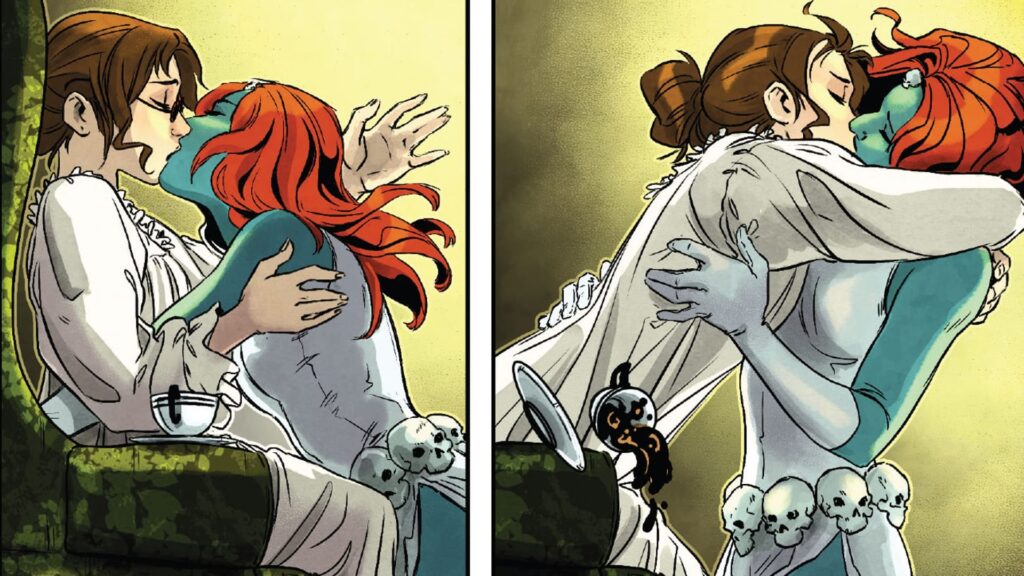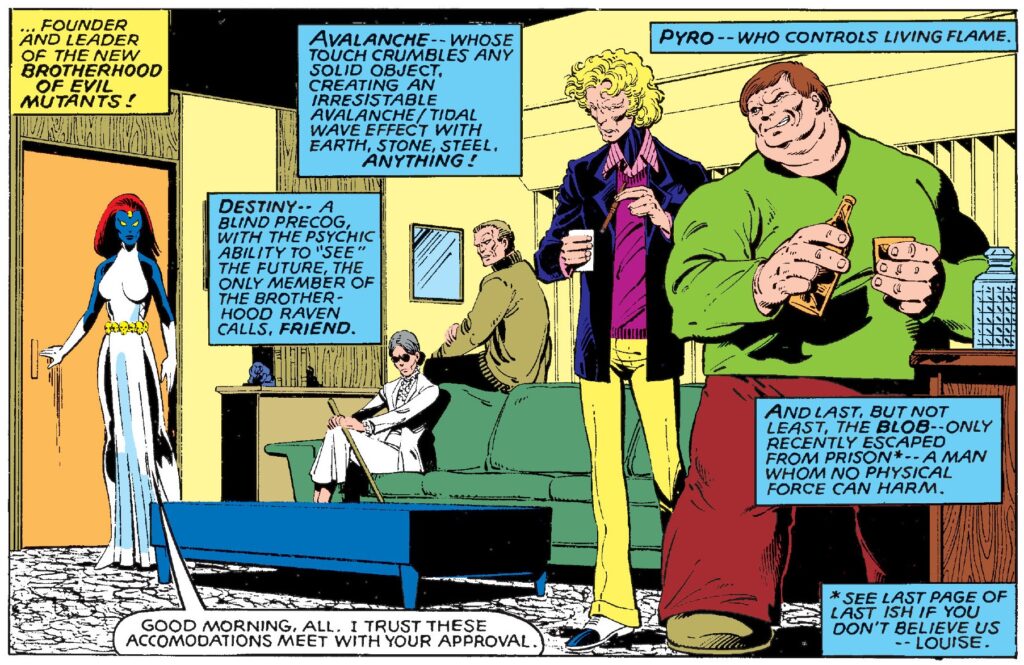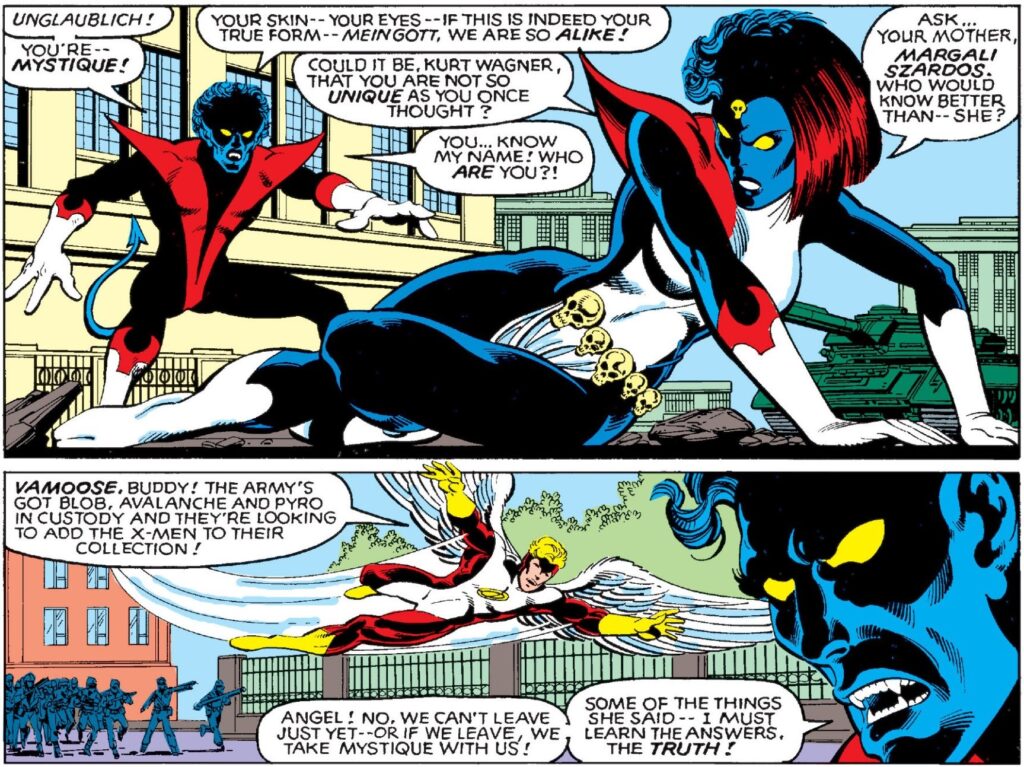
Comics Corner – How X-Men villains Mystique and Destiny were meant to be same-sex parents
This article was originally published on our sister site, Gayming Magazine.
The relationship between Mystique and her wife, Destiny, is one of the longest-running examples of lesbian representation in mainstream superhero comics. Unfortunately, it has the small hitch of not being allowed to openly show the women as more than very close friends for much of the characters’ existences. Due to the restrictions that publishers placed on themselves by adhering to the puritanical Comics Code Authority guidelines, along with general sensitivities and uneasiness regarding presenting LGBTQ+ characters in comic books, for decades the X-Men antagonists were, at best, queer coded.
However, recent stories made it canonical that the pair were not just lovers, but had actually married at some point in their past. Their relationship has even been a key background plot for the duration of the current era of X-Men, where mutants have found a way to cheat death and established an ascendant culture on the living island of Krakoa. However, the architects behind this species-wide revival – Professor X, Magneto, and Moira MacTaggert – have assiduously ensured that Destiny’s turn for resurrection never comes around, fearful that her powers of precognition will interfere with deeper, and perhaps darker, plans. As a result, Mystique – also known as Raven Darkholme – took matters into her own hands, moving heaven and earth to game the system and bring her wife back from the dead.
While the fallout of that power play remains to be seen, it’s worth looking back at how much deeper the Mystique and Destiny’s relationship was meant to go, and how much sooner. It’s a comics history lesson that takes us back to the 1970s, involves a handful of quiet retcons, and has the duo becoming parents multiple times over.

Both characters were created by writer Chris Claremont, with Mystique appearing first in 1978, co-created with artist Jim Mooney as a villain for the original Ms. Marvel. Destiny would follow in 1981, co-created with John Byrne for the pages of X-Men #141. Destiny was introduced as a member of Mystique’s Brotherhood of Evil Mutants, and from the first time readers see her, she’s presented as being special to Mystique, introduced as “the only member of the Brotherhood Raven calls friend”.
That “friendship” would become central to both characters going forward, with Claremont having had plans to establish them as being a romantic pairing decades before it was ever openly stated on the page. Unfortunately, text would remain subtext for years, with the closest the women would come to being in an official relationship would be their taking in Rogue, initially as a member for the Brotherhood, then more closely as a foster daughter.
It’s another member of the X-Men that really ties Mystique and Destiny together though – Kurt Wagner, the teleporting “fuzzy elf”, Nightcrawler. Although raised by a Romani woman name Margali Szardos, the biological parentage of the hero was long in question, although Claremont laid many clues over his long run as writer of the X-Men comics.
The first came when Nightcrawler and Mystique first crossed paths in Uncanny X-Men #142, part of the legendary ‘Days of Future Past’ storyline, which saw the time-travelling mind of Kitty Pryde sent pack to the present day to prevent the assassination of Senator Robert Kelly by Mystique’s Brotherhood. As the two teams battled, Mystique shapeshifted into Nightcrawler, confusing the others until the real Kurt landed a blow, knocking her out of her impersonation – at which point he notices their physical similarities, with their shared blue skin and yellow eyes. To Nightcrawler’s great surprise, Mystique knows not only his real name, but the name of the woman who raised him. However, she escapes before he can interrogate her further.

A few years later, Claremont added to the mystery, in Uncanny X-Men #177. Mystique, training against robot replicas of the X-Men, manages to ‘kill’ all of the then-current members of the team, even Rogue – who had left the Brotherhood and joined the X-Men by this point – but inexplicably hesitates when she finds herself up against Nightcrawler. Nursed back to consciousness by Destiny – another tender moment between the pair, where Destiny calls Mystique “my Raven” – the shapshifter says “I could slay my foster daughter without a second thought – but not Nightcrawler”.
The same issue finds Kurt reflecting on the fight back in #142, with his then-girlfriend Amanda Sefton – AKA Jimaine Szardos, Margali’s biological daughter – telling Kurt that Margali had found him as a baby in the Black Forest, next to the body of a man she presumed was his father. This is where things start to get interesting – and very, very complicated.
While Mystique was ultimately confirmed as Kurt’s mother by writer Scott Lobdell and penciller Richard Bennett in 1994’s X-Men Unlimited #4, the identity of his father remained, for decades, unconfirmed. His surname Wagner came from his legal father, Christian Wagner – who had earlier been identified as Eric Wagner, another incongruity in Nightcrawler’s parentage – a German Baron whom Mystique had married for power and prestige, but his paternal lineage remained unknown.
Years later, in a 2003 storyline called The Draco, Kurt’s father would finally be confirmed as Azazel – a red-skinned, seemingly immortal, and most tellingly, teleporting mutant, but prior to that, Claremont had other plans. At one point, the intention was to reveal that Kurt was part dream demon, with the biological father being Nightmare, although this was vetoed by Doctor Strange writer Roger Stern, who didn’t want one of his key villains tied up in an X-Men plot. Another story began in Uncanny X-Men #204, where Nightcrawler rescued a woman named Judith Rassendyll, who turned out to be the long-lost heir to the fictional European country of Ruritania and its royal family, the Elfburgs. Solicited as detailing “the truth about [Nightcrawler] and his origin”, ultimately nothing came of it – just two issues later, Kurt saw Judith off at the airport, with any plans to tie in with Kurt’s origins abandoned.

By far the most interesting though brings us back to Mystique and Destiny, with Claremont wanting to reveal the woman as Kurt’s biological parents. Yes, both of them – with Mystique to have been revealed as shifting into a male form to impregnate Destiny.
While this would have been beyond groundbreaking, it seemed doomed to never see the light of day. Not only would it have required being able to confirm the two women as being in a relationship – potentially years before the reveal of Northstar as Marvel’s first openly gay character – but it would also have established a complex trans narrative that the mainstream comics industry absolutely wasn’t ready for. Although this revelation never materialised, it’s possible it was planned to have been revealed in an unreleased late 1980s graphic novel that Claremont was working on with his Excalibur co-creator Alan Davis, that would have revealed the connection between Nightcrawler and Mystique.
Scott Lobdell is often quoted as saying that “It was always Chris’ plan that Mystique and Irene Adler (Destiny) were lovers, and that Mystique at one point had transformed into a man and impregnated Destiny and she gave birth to Nightcrawler. So Mystique and Destiny were actually Nightcrawler’s father and mother. The likelihood of either A, Mystique growing genitals with sperm that had a DNA-code, or B, Mystique being a guy who was perpetually in the body of a woman, I thought was pretty slim.”
Whether Claremont’s planned reveal would have also meant establishing Mystique as having been biologically male is unknown, but it’s a mark of how far the comics industry has come that in the 1990s, the idea of Mystique potentially being trans was “pretty slim”. Here in the 2020s, the idea that Mystique could have been assigned male at birth but been blessed with the mutant power to live in the body she needed would likely be welcomed, especially by LGBTQ+ readers.
Canonically, then, Mystique and Destiny are not Nightcrawler’s biological parents. However, the fact that they almost were shows how much deeper the relationship between the two women was meant to be, decades before they could even be together – a committed couple who had both foster and biological children together. While it’s fantastic that they can openly be married now, it could have been even more progressive.












